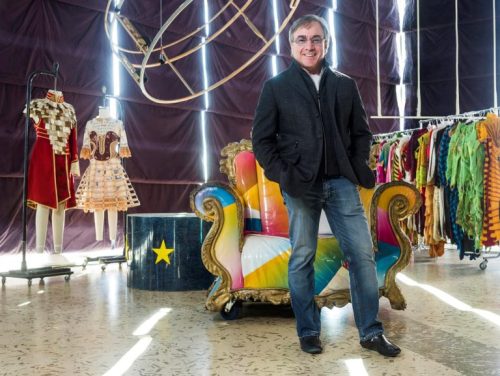I faced a steep curve trying to learn the business when I started at Cirque du Soleil. By the fall of 2001, about ten months after I arrived, it was clear the company was facing an existential crisis triggered by the departure of its top director, Franco Dragone. After fifteen years of doing things a certain way—Dragone directing new productions, with oversight by company founder Guy Laliberté—we suddenly had to develop a new way to create our shows. Regardless of the type of organization, this kind of situation should always be seen as an opportunity to review existing practices and processes rather than getting defeated and giving up.
For us, this turned out to be an opportunity in disguise when we decided to try something new: Bring in new directors from the outside. It takes nothing away from Dragone’s accomplishments to say that the string of hits that would follow his departure, in what some refer to as our golden years—Varekai, Zumanity, KÀ, Corteo, The Beatles LOVE, Michael Jackson ONE, and more—showed how stimulating it can be for a company to bring in outside talent with fresh perspectives on what your product can be.
Until then, our biggest concern was that each new production would seem too similar to the last one. Bringing in outside talent solved that problem. Every new show bore the signature of a particular director, thus diversifying our content.
As we experimented with this new process, however, we knew it carried its own set of risks: The newcomers would know nothing about how our company operates and teaching them would be tremendously costly and time-consuming. In our case, many of the directors we considered hiring were top talent from the worlds of theater, opera, dance, and music but had zero experience with circus acts.
Another issue: once you invite these outsiders in, how do you keep them on track and make sure they get the job done? We can encourage wild creativity and fresh ways of approaching a show, of course, but that does not mean anything goes. We still needed a process to create high-quality productions, recognizably Cirque du Soleil, within our defined budget and time frame. There had to be a delicate balancing act, in other words, between the outrageously creative and the rigorously practical.
To solve these problems, we decided to try something new: Assign two longtime staff members—a director of creation and a director of production—to help translate the director’s artistic vision into reality. They would serve as guides who set up the parameters of the sandbox and then let the director play.
The director of creation would be responsible for offering up all the personnel the director might need, from casting and costumes to performers and coaches. “Do you want a skateboarder here?” they might say. “Or a trapeze artist? Or maybe we should create an entirely new apparatus for the acrobats to perform on?”
Meanwhile, the director of production would make sure the show stays within budget and on schedule. This person would be an expert on getting things done and know how to manage a typical $30 million Cirque du Soleil budget. For example, with touring shows, the equipment must fit inside the fifty trucks we have available, no more. “If you want ten musicians, fine,” the director of production might say, “but you’ll have to cut two acrobats.” This creates efficiencies, cutting off ideas that we can’t afford or that won’t work in the given time frame.
As you can imagine, inventing a new show is an elaborate process, taking about two years for a touring production. Resident shows take longer, usually three years, because we must also oversee the construction of the theater, which can be an enormous job. Just consider the massive water-tank stage for “O” at the Bellagio or the giant rotating stage for KÀ at the MGM Grand in Las Vegas.
Cirque’s first production under our new system was the touring show Varekai. By the time I got involved, it was already deep in rehearsals and only six months away from its premiere in Montreal in the spring of 2002. Guy chose as director Dominic Champagne, an award-winning Canadian playwright and theater director who had designed and directed many prestigious public events, including several editions of Québec’s national holiday celebrations. Dominic had never created a circus show before, but we could provide that expertise. Guy was looking for someone with a fresh artistic vision who was excited about the chance to use circus arts to execute it.
Fortunately, the new system worked beautifully. Dominic brought in the kind of counterintuitive idea we were hoping for. He said, “The acrobatic acts in Cirque are often about flight, so how about a story about falling?” When Dominic was young, he fell from a tree and broke his leg, unable to walk for many months. The experience was quite traumatic. That gave him an idea: Why not reimagine the myth of Icarus by starting the show with the brash young man’s fall back to earth? We let him run with the idea and trusted our experienced directors of creation and production to keep the project on track.
When Varekai premiered, we had another new hit show. Over the years, it has been seen by six million people worldwide. More importantly, we proved that Cirque du Soleil could thrive using a variety of directorial voices. “Daniel, we will never ever be held hostage by one director!” Guy told me, ecstatic after the premiere. “Now we will be truly independent and control our own future.”
This process—recruiting outside talent and teaming them with guides from within the company—is something any business can do. If I were chief executive of a car company, for example, I would hire accomplished engineers and designers who had never made cars before to see what they came up with. They would not have to know anything about building engines because we would already have experts to do that. Instead, I’d want that designer to focus exclusively on making the most creative, fashionable, and functional car possible.
If this approach sounds fanciful, consider that business history is full of game-changing products that emerged from entirely different fields: bubble wrap was originally a new kind of textured wallpaper until someone thought to use it for protecting items during shipping. The Slinky was a stabilizing device for ships before someone knocked it over, watched it walk across a desk, and discovered a new toy. Viagra was invented to lower blood pressure and treat heart disease until researchers realized it had another powerful effect.
Watching Varekai develop into a hit show gave me a business lesson I never forgot: You will never know what brilliant products are out there, undiscovered, until you open your company’s doors and minds to new possibilities.
Reprinted by permission of HarperCollins Leadership, an imprint of HarperCollins Focus LLC. Excerpted from Balancing Acts: Unleashing the Power of Creativity in Your Life and Work. Copyright 2022 Daniel Lamarre. All rights reserved.
{ SOURCE: CSQ }

